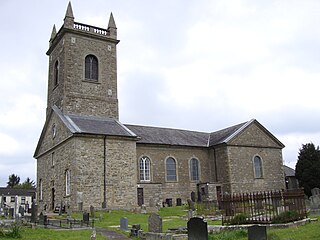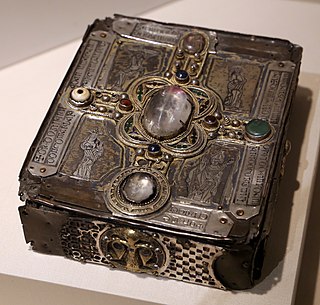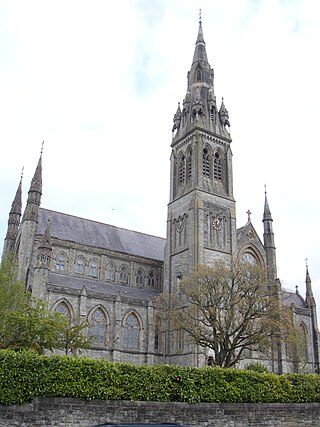Joseph Duffy was the Roman Catholic Bishop of Clogher in Ireland, a position he held from 1979 until his retirement on 6 May 2010. He resides in Monaghan Town, County Monaghan, Ireland.

Clogher is a village and civil parish in the border area of south County Tyrone, Northern Ireland. It lies on the River Blackwater, 5.8 miles from the border crossing to County Monaghan. It stands on the townlands of Clogher Demesne and Clogher Tenements. The 2011 Census recorded a population of 717. The civil parish of Clogher covers areas of County Fermanagh as well as County Tyrone.

The Bishop of Clogher is an episcopal title which takes its name after the village of Clogher in County Tyrone, Northern Ireland. Following the Reformation, there are now parallel apostolic successions: one of the Church of Ireland and the other of the Roman Catholic Church.

A cumdach or book shrine is an elaborate ornamented metal reliquary box or case used to hold Early Medieval Irish manuscripts or relics. They are typically later than the book they contain, often by several centuries. In most surviving examples the book comes from the peak age of Irish monasticism before 800, and the extant cumdachs date from after 1000, although it is clear the form dates from considerably earlier. The majority are of Irish origin, with most surviving examples held by the National Museum of Ireland (NMI).

Secundinus, or Sechnall as he was known in Irish, was founder and patron saint of Domhnach Sechnaill, County Meath, who went down in medieval tradition as a disciple of St Patrick and one of the first bishops of Armagh. Historians have suggested, however, that the connection with St Patrick was a later tradition invented by Armagh historians in favour of their patron saint and that Secundinus is more likely to have been a separate missionary, possibly a companion of Palladius.

St. Macartan's College is a Roman Catholic boys' Diocesan College in Monaghan, Ireland. It is named after Saint Macartan, follower of St. Patrick and founder and bishop of the Diocese of Clogher. The school educates Catholic boys in County Monaghan and surrounding counties. It is located within the parish of Donagh. The school Feast Day is 24 March.

The Diocese of Clogher is a Latin Church diocese of the Catholic Church in Ireland. It was formed in 1111 at the Synod of Rathbreasail as the see for the Kingdom of Uí Chremthainn. It is part of the Province of Armagh.

The National Museum of Ireland – Archaeology is a branch of the National Museum of Ireland located on Kildare Street in Dublin, Ireland, that specialises in Irish and other antiquities dating from the Stone Age to the Late Middle Ages.

St Macartan's Cathedral is the cathedral church of the Roman Catholic Diocese of Clogher in Ireland. It is located in the townland of Latlurcan, Monaghan town in the ecclesiastical parish of Monaghan and Rackwallace. It was built between the years of 1861 and 1893 and is the only Catholic cathedral in the county.

St Macartan's Cathedral, Clogher is one of two cathedral churches in the Diocese of Clogher in the Church of Ireland. It is situated in the village of Clogher, County Tyrone, Northern Ireland in the ecclesiastical province of Armagh.
Saint Fedelmid Find was the Bishop of Armagh, Ireland from 558 to 578.

The Domnach Airgid is an 8th-century Irish wooden reliquary. It was considerably reworked between the 13th and 15th centuries and became a cumdach or "book shrine", when its basic timber structure was reinforced and decorated by elaborate silver-gilt metalwork. Its front-cover was enhanced by gilded relief showing Jesus in "Arma Christi", alongside depictions of saints, angels and clerics, in scenes imbued with complex iconography. It is thus considered a mixture of the early Insular and later International Gothic styles.

The Breac Maodhóg is a relatively large Irish house-shaped reliquary, today in the National Museum of Ireland. It is thought to date from the second half of the 11th century, and while periods as early as the 9th century have been proposed, the later dating is believed more likely based on the style of its decoration.

The Shrine of Miosach is an elaborately ornamented 11th-century Irish cumdach. It originates from Clonmany, north County Donegal, and is first mentioned in the 1165 Irish annals. It is dated to the late 11th century, when it probably contained a manuscript with psalms or extracts from a Gospel. However, the shrine was empty when first described in detail in the 18th century. It was originally associated with St Cairneach, patron saint of Dulane, County Meath, but by the late medieval period had become part of the cult of the abbot and missionary Colm Cille.

The Soiscél Molaisse is an Irish cumdach that originated from an 8th-century wooden core embellished in the 11th and 15th centuries with metal plates decorated in the Insular style. Until the late 18th century, the shrine held a now-lost companion text, presumed to be a small illuminated gospel book associated with Saint Laisrén mac Nad Froích, also known as Molaisse or "Mo Laisse". In the 6th century, Molaisse founded a church on Devenish Island in the southern part of Lough Erne in County Fermanagh, with which the cumdach is associated.

The Moylough Belt-Shrine is a highly decorated 8th-century Irish reliquary shaped in the form of a belt. It consists of four hinged bronze segments, each forming cavities that hold strips of plain leather assumed to have once been a girdle belonging to a saint and thus the intended relic. It remains the only known relic container created as a belt-shrine, although such objects are mentioned in some lives of Irish saints, where they are attributed with "remarkable cures", and there are surviving reliquary buckles in continental Europe. The belt may have been influenced by 7th-century Frankish and Burgundian types.

The Shrine of St. Patrick's Bell is a bell shrine reliquary completed c. 1094–1105 in County Armagh, Ireland, to contain a c. 500 iron hand-bell traditionally associated with the Irish patron saint Saint Patrick. Inscriptions on the back of the shrine record that it was commissioned after 1091 by the Uí Néill High King Domnall Ua Lochlainn and completed c. 1105 by the metalworker Cú Dúilig, about whom nothing is known. Both objects are historically significant, with the bell being one of the few Irish very-early medieval artifacts with a continuous provenance lasting from around the 8th century to the present, and the shrine being a highpoint of Irish metalwork from the late Insular and early Romanesque periods.
Cormac Bourke is an Irish archeologist specialising in Medieval studies, early church history and insular Christianity. He is a former, long term, curator of Medieval Antiquities at the Ulster Museum, Belfast, and currently works at the antiquities department of the National Museum of Ireland.

The Shrine of St Patrick's Tooth is a medieval reliquary traditionally believed to contain a tooth belonging to Patrick, Ireland's patron saint, who lived in the 5th century. The shrine comprises a wooden case lined with bronze and decorated with gold, silver and amber fittings, and was built in two phases. Its basic structure and the central ringed crosses on either side are 12th century, while the purse-shaped form and most of the metal work, including the saints, were added in the 1370s when the object was substantially refurbished.

Bell shrines are metal objects built to hold early medieval hand-bells, particularly those associated with early Irish saints. Although the enshrinement of bells lasted from the 9th to the 16th centuries, the more well-known examples date from the 11th century. Nineteen such Irish or British bell shrines survive, along with several fragments, although many more would have been produced. Of those extant, fifteen are Irish, three are Scottish and one is English. Most follow the general shape of a hand-bell capped with a crest above a semicircular cap that matches the shape of a bell handle.














